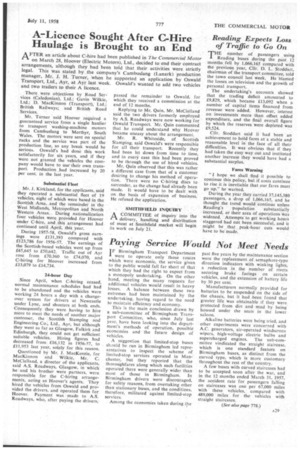PayingService Would Not Meet Needs
Page 31

If you've noticed an error in this article please click here to report it so we can fix it.
IF Birmingham Transport Department
were to operate only those routes which were economic, the service given to the public would fall far short of that which they had the right to expect from a monopoly undertaking. On the other hand, meeting the many requests for additional vehicles would result in heavy losses. A balance between these two extremes had been maintained by the undertaking, having regard to the need to maintain efficiency and economy.
This is the main conclusion drawn by a sub-committee of Birmingham Transport Committee, who, since July last year, have been looking into the department's methods of operation, possible economies and the future design of vehicles.
A suggestion that limited-stop buses should be run in Birmingham led representatives to inspect the scheme of limited-stop services operated in Manchester, but they reported that the thoroughfares along which such facilities operated there were generally wider than most of those in Birmingham. In Birmingham drivers were discouraged, for safety reasons, from overtaking other than stationary buses, and the ceinditions, therefore, militated against limited-stop services.
Among the economies taken during the past five years by the maintenance section were the replacement of semaphore-type direction indicators with winking lights, a reduction in the number of rivets securing brake facings on certain vehicles, and the extension of battery life by 30 per cent.
Manufacturers normally provided for batteries to be suspended on the side of the chassis, but it had been found that greater life was obtainable if they were protected from dirt and mud by being housed under the seats in the lower saloon.
Alkaline batteries were being tried, and other experiments were concerned with A.C. generators, air-operated windscreen wipers, high-voltage electric bulbs and supercharged engines. The sub-committee vindicated the straight staircase, which is one standard feature on Birmingham buses, as distinct from the curved type, which is more customary throughout the rest of the country.
A few buses with curved staircases had to be accepted soon after the war, and in the 12 months ended March 31, 1957, the accident rate for passengers falling on staircases was one per 67.000 miles with these vehicles, compared with 489,000 miles for the vehicles with straight staircases.




































































































